News
Research in and for Africa
Showcasing at the Pan-African Horticultural Congress, #AAHC2024, the sixth edition of the All Africa Horticultural Congress, held in Marrakech from February 24 to March 1, 2024
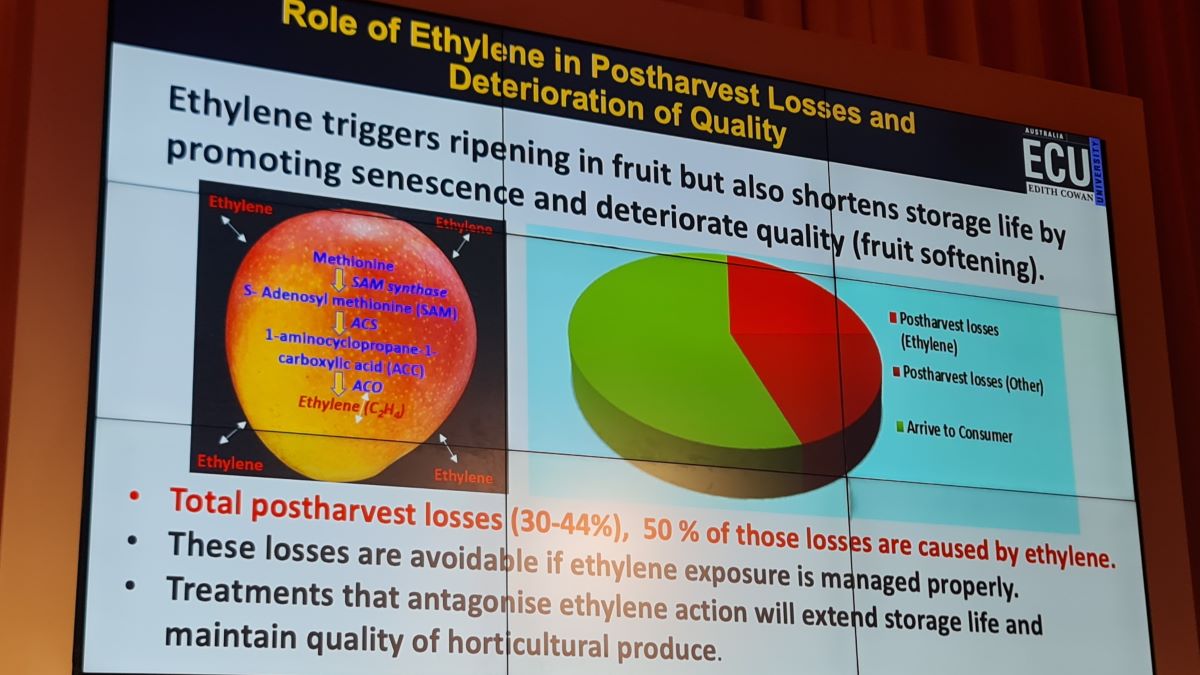
It is estimated that by the end of this century, one in four people worldwide will have been born in Africa. "Africa can feed the world," was a key message at the Congress, highlighting that 10 of the world's fastest-growing economies are African.
The International Society for Horticultural Science (ISHS) is organizing a congress dedicated to this continent. From February 26 to March 1, 2024, the fifth edition of the All Africa Horticultural Congress (AAHC 2024) took place, co-organized with the University Mohamed VI Polytechnic (UM6P), under the leadership of Hicham El Habti.
The All Africa Horticultural Congress has previously been held in Kenya in 2009, South Africa in 2013, Nigeria in 2016, and Senegal in 2021. Almost 300 participants from 46 countries across Africa, the Americas, Canada, Europe, Asia, and Australia announced their attendance. Prof. Abdelhaq Hanafi, the president of AAHC, played a pivotal role in ensuring the success of the Congress. In his acknowledgments, he specifically thanked Professor Redouane Choukr-Allah and his team for their dedicated time and efforts.
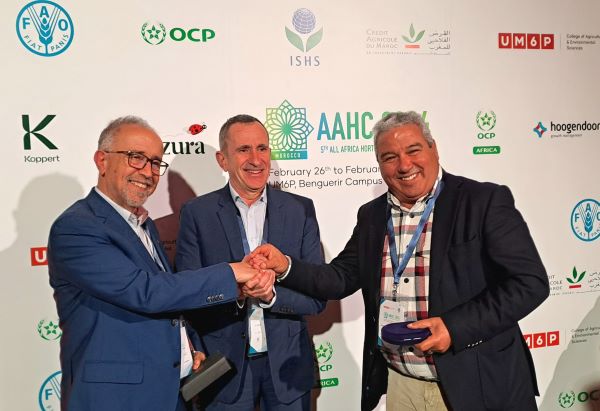
From left to right, Redouane Choukr-Allah, Co-President of AAHC 2024, François Laurent, President of ISHS, and Abdelhaq Hanafi, President of AAHC 2024
The President of the ISHS, Prof. François Laurent, was also present and outlined the strategic objectives of the society, including fostering greater interaction with the general public. Remy Kahane from CIRAD and Melinda J. Knuth from NC State University presented awards for the best posters and presentations by young researchers.
Congress-related excursions included visits to farms growing Charentais melons, seedless table grapes, pomegranates, and Nadorcott mandarins. In Agadir, attendees toured the packinghouse of Duroc, a company that is part of the Delassus Group.

Globalscan G7UV team from Maf Roda at Duroc's packinghouse, which supplies one in every four cherry tomatoes consumed in the United Kingdom; pictured is Pere Papasseit
Categories of ripeness that are sorted at Duroc's packinghouse
The Challenges of Africa
The objectives of the congress were to address the challenges facing Africa. In the words of Prof. Hanafi:
"With 60% of the world's arable land, the African continent can feed the global population. With 30% of critical minerals, Africa is essential for the green transition in the world. But beyond what nature has given to our continent, Africa is working hard, and in 2023, six of the ten fastest-growing countries are from this continent."
In an interview with FAAPA (Federation Atlantique des Agences de Presse Africaines), Hanafi indicates that:
"Digitalization and innovation play a crucial role in the development of resilient horticulture in Africa. Technologies such as precision agriculture, climate-resistant crop varieties, mobile technology, irrigation technologies, supply chain management, data analysis, and financial technology can significantly improve the productivity and sustainability of the sector."
These technologies are tools to address regional and global challenges, such as climate change, new biotic stresses, water scarcity for irrigation, and water stress.
During conversations with congress members during one of the visits, the interviewee explains his conviction that Africa should not depend on external aid; it has enough potential to progress through its own human and material resources. The congress motto, "unlocking the potential of resilient horticulture in Africa," is allusive.
Food security underlies many efforts, and even more so, food emancipation. Currently, only 1% of investments in Africa go to the food sector, warns Ismahane Elouafi of CGIAR, a consortium of research centers whose work is to increase food security. The continent has a website, Aflasafe, dedicated to preventing the dangers of aflatoxins; they have introduced the Aspergillus strain developed by the University of Arizona, which does not produce aflatoxins and is capable of displacing local strains.
Climate change has a particularly significant effect on a continent where agriculture is the way of life for more than 60% of the population. Studies indicate that yields can decrease by 30%.
To this challenge, Nazim Gruda of the University of Bonn adds the decrease in arable land and the increase in urbanization. In the two possible strategies for addressing climate change, adaptation, and mitigation, one of the examples he mentions is that the use of biofertilizers can lead to a 20% reduction in fertilizer use, which, among other positive effects, means reducing the carbon footprint.
In Support of a More Resilient Africa
Professor Bruno Gerard of UM6P, University Mohamed VI Polytechnic, which hosted the Congress, emphasized that one of the main objectives of the meeting is to strengthen Africa's resilience through better nutrition by cultivating vegetables for local consumption and avoiding food waste. It is estimated that a 30% food waste equates to a 25% waste in water usage alone.
In addition to water usage, there are also concerns about fertilizers, carbon footprint, etc. For Morocco, agriculture represents 46% of employment and 50% of GDP; horticulture is labor-intensive, but remuneration is low.
At CIRAD, the French organization for research and international cooperation, five challenges related to Africa were identified. Sandrine Dury explained that these include water management (CIRAD has a dedicated unit for this); co-designing solutions based on bioaggressors, caring for soil fertility, and promoting agroecology in general; diversifying diets; harnessing the multifunctionality of horticulture, addressing landscape considerations, efficient water use, etc.; and increasing digital opportunities to benefit small-scale producers.
CIRAD's priorities also include combating HLB (HuangLongBing), citrus greening disease caused by the Candidatus Liberibacter spp. bacterium and transmitted by two species of psyllid insects, which is a widespread concern. They also aim to promote the development of varieties adapted to different conditions. The issue of genetic resources received special attention during the Congress, given its importance for successful horticulture. Efforts are being made not only to enhance adaptation and yield but also to improve nutritional quality, including higher protein content and anticancer properties.
Digitalization
In the perspective of Remi Kahane, also from CIRAD, digitalization eliminates the concept of remote locations. It serves as an equalizer of opportunities. In Africa in general, and particularly in sub-Saharan areas, there is still a long way to go to achieve the desired level of digitalization. The importance of ensuring that the first digital experiences are successful is emphasized, as failure can lead to frustrating setbacks that are challenging to overcome.
Benjamin Abugri from FARA (Forum for Agricultural Research in Africa), the primary continental organization responsible for coordinating and promoting agricultural research, emphasizes the importance of delivering knowledge to end-users (and the significance of identifying the "ultimate user"). They also address issues related to fake news and stress the importance of educating people on how to identify misinformation.
A presentation highlighted the transformative impact of mobile phones on small-scale farmers, particularly when they have smartphones and access to the Internet, although the latter is still expensive, costing around five times as much as in Europe. Mobile phones enable farmers to access market opportunities, prices, exchange knowledge, and even conduct money transfers. The videos they watch are typically informal, not from research agencies.
The Role of Women
Erin J. McGuirre, Director of the Horticulture Innovation Lab at UC Davis, mentions that one of the key elements to increase the resilience of productive systems in Africa is to value the role of women. She highlighted the significant role many women already play in research, which was also reflected in the presentations and attendance at the Congress.
A common experience among foreign agencies in Africa is the importance of collaborating with local experts. The web facilitates contact through a prominent form on the site: https://horticulture.ucdavis.edu/contact
Local Production to Improve Nutrition
Yuksel Tuzel from Ege University in Turkey highlighted the role that simplified hydroponics can play in local food production. Various simple options were presented, adapted to utilize locally available materials.
Low-tech vertical horticulture was the subject of a presentation by Professor Francisco Orsini from the University of Bologna, emphasizing the importance of considering locally available materials when starting a project. Also stressed was the importance of creating groups to share responsibilities to ensure the success of the venture. Production levels between 20 and 40 kg/m2 can be achieved; an area of 2 to 7 m2 may be sufficient to feed one person with 200 g of vegetables per day. It has been found that having access to vegetables through these systems increases the frequency of vegetable consumption; people who only consume vegetables 3 or 4 times a month may do so more frequently. Water savings can reach up to 90%.
The Congress also featured technologies such as artificial lighting and innovations in fertilization, such as research presented by Katja Hora from SQM International on the role of iodine in plants, a micronutrient that is typically overlooked. The work "Evidences for a Nutritional Role of Iodine in Plants," by Kiferle et al. in 2021, demonstrates this. Biological control against insects features products from Koppert and Biobest, whose representatives in Morocco gave respective presentations.
Nutrition
There are also similarities in Africa compared to other continents... Bibi Glyose, a nutritionist from South Africa, emphasized the importance of involving young people in food systems, which are currently dominated by older individuals. She also noted that Africa does not lack policies; what is lacking is their implementation.
Nutritional ignorance is another shared aspect with other parts of the world, and the solution lies in informing and training. Furthermore, leveraging local biodiversity is essential; Africa has species like Amaranthus, which has high iron, zinc, thiamine, riboflavin, and niacin content. It is a spontaneous species with potential for cultivation.
In addition to the few facilities for processing what is grown, there is a growing consumption of "exotic" species, sidelining indigenous ones. Bibi encouraged participants, through her example, to engage in moments of exercise to reset their minds during the intense sessions of the Congress, which was greatly appreciated.
Is there interest in organic products? Rahim Quedraogo from CIRAD explained that high-income levels, according to the results of a survey conducted in Côte d'Ivoire on 2,189 heads of households, would be willing to pay up to 20% more for such products. The interest exists, although undoubtedly, there are other priorities at a general level. The same study indicates that most consumers are not prepared to pay higher prices for organic vegetables, even knowing they may be better for their health.
Professor Hanafi commented during one of the visits that he was the pioneer of organic farming in Morocco; however, currently, with the quality certifications implemented by numerous companies, he considers this a sufficient guarantee of safety.
Biodiversity
Preserving species, utilizing traditional species, and generally maximizing the potential of plant diversity beyond the approximately 40 fruit and vegetable species available in the market are concerns for numerous researchers. Laila M. Karlsson discussed the propagation of Ensete ventricosum, a relative of bananas used in Ethiopia and known for its drought tolerance, with potential interest for other regions.
Mathieu Ayenan from the World Vegetable Center explained the institution's work in promoting varieties in Sub-Saharan Africa. The general situation in Africa is that no country engages in plant breeding, private investment is very low, and there is a limited variety of choices.
Similar to potatoes, Peru boasts the greatest diversity of another Solanaceae, the pepper. Roberto Ugas from the National Agrarian University La Molina explained efforts to promote the Mochero pepper (Capsicum chinense), an ancestral variety cultivated in northern Peru, in favor of small-scale producers. It is a spicy pepper known for its flavor and aroma.
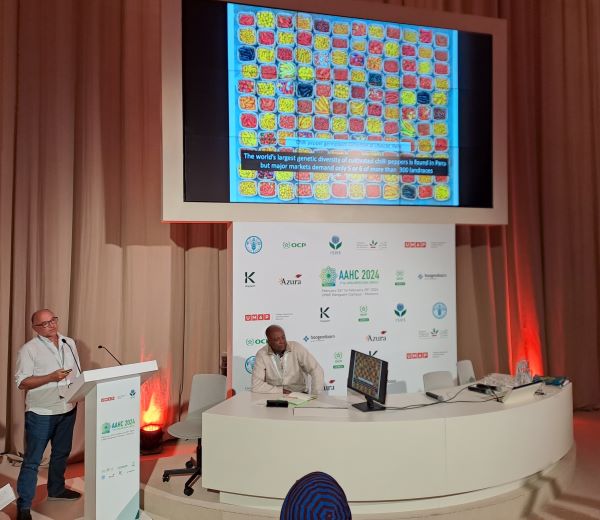
Roberto Ugas from the Universidad Nacional Agraria La Molina sheds light on the biodiversity present in Peru, while Patrick Kumah from KNUST, Kwame Nkrumah University of Science and Technology in Ghana, presides over the session
Other realities
Africa itself presents diverse realities, with the Sub-Saharan region having less development compared to the northern part of the continent and South Africa.
The different climatic conditions of these zones contribute to these differences; the tropical conditions in several Sub-Saharan countries pose particular problems, such as with Ralstonia solanacearum. The high temperatures and humidity favor the severe impact of this bacterium on tomato cultivation. Issouf Sanga from INERA (Institute of Environment and Agricultural Research) in Burkina Faso presented ongoing efforts to control the bacterium using mycorrhizae.
Postharvest
Ethylene, Responsible for Half of the Losses
According to Zora Singh from Edith Cowan University in Australia, 60% of postharvest losses are preventable. Reduction must be addressed holistically, and both individuals and governments have significant roles to play in food and nutritional responsibilities.
Responsible for 50% of this 60% of losses is ethylene, which initiates the ripening process followed by senescence. Controlling the effects of this gas is the primary objective of Singh's research group. They study substances with effects similar to 1-MCP and reversible effects, as well as others like melatonin.
One possible alternative to 1-MCP is NC, 1H-cyclopropa(b)napthalene; in one of the images, Singh showed how it prevents flower abscission in Geraldton wax flower cv Purple Pride (Chamelaucium uncinatum) when applied through fumigation. The other alternative is BC, 1H-cyclopropylbenzene, which controls ethylene production and respiration in fruit.
The conclusion is that "BC and NC effectively block ethylene action, possibly through a reaction between these compounds and the ethylene receptor catalyzed by the Cu(l) cofactor. Both fresh fruit and flowers become insensitive to ethylene action and can therefore be used to prevent the negative effects of ethylene."
This research group also works on mitigating cold damage in stone fruit and oranges, modulating ripening and early color development in persimmons using methyl jasmonate, quality deterioration in raspberries and blackberries (good results were obtained in these berries by applying melatonin), extending post-harvest life of jackfruit, etc.
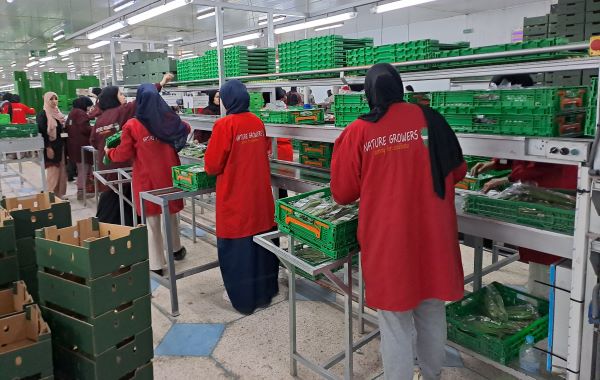
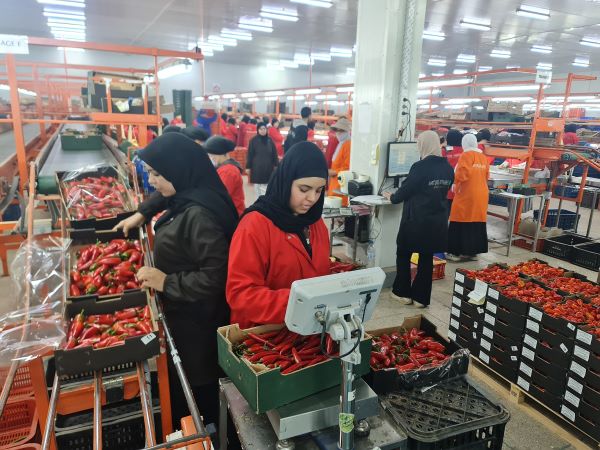
Preparation of green beans at Agroatlas, Agadir. The company also produces round green beans in various formats, various types of hot peppers (2nd image), and in smaller quantities cucumber and other species
Important Local Species
Biodiversity in use in Africa is undoubtedly greater than in Europe, but they also face a process of diversity loss, exacerbated by migration to cities. Gloria Esselife from the University of Ghana presented a study on the preservation of Colocasia esculenta or Xanthosoma sagittifolium leaves (taro leaves, whose tuber can be found in ethnic stores). It is an underutilized vegetable due to post-harvest difficulties with the leaves, especially for consumption in urban areas. They experimented with blanching, sodium metabisulfite, freezing, or solar drying and storage temperature, and found that the best results were obtained with sun drying and freezing. A presentation easy for consumption is feasible for adoption in cities, which would contribute to better nutrition.
Jackfruit is a strikingly large tropical fruit; Jashanpreet Kaur from Edith Cowan University studied the impact of genotypes grown in Australia on mineral concentration. This knowledge contributes to nutritional security by identifying primary mineral levels in the ripe pulp of this fruit.
Researchers from Uganda presented several studies linked to water needs in the cultivation of Solanum aethiopicum; nakati, bitter eggplant, or African eggplant are some of the names for this solanaceous vegetable consumed mainly for its leaves.
Coatings and Waxes
Matholo Joyce Mothapo from the University of Limpopo, South Africa, studied the application of Citrashine on Turkey oranges and demonstrated that the effectiveness of the treatment can be improved by applying the treatment for a longer period.
At the University of Stellenbosch, coatings using alginates activated with plasma are being studied. Ngoako F. Monyela presented the trial conducted on Packham pears, and the general conclusion is that this type of coating could successfully replace single-use plastics, although this treatment alone was not able to inhibit Penicillium expansum.
Natural Compounds with Preservative Effects
In Stellenbosch, they also studied the application of crude extracts of Helichrysum patulum as an alternative control for post-harvest management of Botrytis cinerea on nectarines, extracted using ethanol or acetone. All extracts showed in vitro greater action than Rovral, the commercial fungicide against which they were tested (Zinash Belay et al.).
At the University of Cyprus, Panayiota Xylia et al. study the application of lavender and rosemary essential oils to preserve zucchinis. Preliminary results are positive, and further studies are needed to determine concentration, time, and application methods.
The same researcher also studies oregano essential oil and hydrosol (i.e., the water-soluble parts of the plant (this liquid also contains microscopic drops of essential oil)) to preserve basil. They increase the phytochemicals of interest in basil, and future research should adjust the best application methods.
Sabelo Shezi and Nkosisphile, S. Khoza, from Mpumalanga Mbombela, South Africa, experiment with post-harvest treatments of Hass avocados with thyme and lemon grass; the results indicate that they could potentially replace currently used treatments.
Physical Methods
A study demonstrates the curative efficacy of acidic electrolyzed water (AEW) and alkaline electrolyzed water (AlEW) against Botrytis cinerea and Penicillium expansum on 'Granny Smith' apples. Nandi E. Sra. Nyamende from the University of Stellenbosch found that both types of water have an effect, and the curative efficacy against B. cinerea and P. expansum was higher with the higher concentration of 300 mg L-1, followed by 200 mg L-1 for the treated apples, while the lower concentration of 100 mg L-1 was not effective against both pathogens. These findings suggest the potential of AEW or AlEW treatments as an effective antifungal treatment against B. cinerea and P. expansum for better apple preservation.
Cold plasma (CP) is an ionized gas generated by passing gas through an electric field and is considered the 4th state of matter. It is an emerging technology with wide application in sustainable food systems for its potential to eliminate toxic or hazardous chemicals and for its efficiency in sterilization and decontamination as well as its ability to be used on heat-sensitive materials.
Low-pressure cold plasma was used on mangoes from the Tropica, Heidi, and Keitt cultivars (Loriane A. Yanclo et al., University of Stellenbosch) to evaluate changes in quality-related parameters. Oluwafemi James Caleb, from the University of Stellenbosch, who presented the work, explained that cold plasma (CP) was applied for 5 and 10 minutes at a working voltage of 90 kV and 1.4 mbar, demonstrating that this treatment can be used as an appropriate pre-treatment to preserve the nutritional quality of fresh mango fruit as well as its food safety, by reducing counts of aerobic mesophilic bacteria in the treated fruits.
Another study tests the application of atmospheric cold plasma (ACP) (5 min, 90 kV) to control Botrytis cinerea and Monilinia spp. inoculated on nectarines and stored at 20°C for 10 days (Zinash Belay et al., also presented by O. J. Caleb, University of Stellenbosch).
The results showed that ACP treatment can effectively delay/inhibit the growth of both Botrytis cinerea and Monilinia spp. throughout storage. There was a difference in susceptibility between Botrytis cinerea and Monilinia spp. to the action of cold plasma. The researchers indicate the need to investigate the effects of short- and long-lived reactive species and their impact on overall fruit quality.
Tomato
In tomato, one of the research studies focused on the successful application of calcium chloride to improve its conservation, by Nhlanhla Mathaba, also from the University of Limpopo. They recommend a post-harvest CaCl2 treatment of 0.01 to 0.03%.
Root Vegetables
Several studies were presented on potatoes, one of them (Tieho Paulus Mafeo et al., University of Limpopo) aimed at understanding aspects related to the occurrence of acrylamide. They concluded that potatoes produced in different locations have different sugar contents, which explains the varying presence of the undesirable compound.
Dehydrated sweet potato is an interesting snack; Khuthadzo Mugodo et al., study the effect of different processing methods on color and beta-carotene content. The use of combined drying methods, pre-drying blanching, and variety selection allow for reducing the time needed to dry sweet potatoes while preserving quality.
The Next AAHC
The next edition of the All Africa Horticultural Congress will be hosted by Uganda, which presented its candidacy with great enthusiasm in Marrakech. Among the main promoters of this candidacy is Professor Elizabeth Kizito (pictured below during the presentation), Director of Research, Partnerships, and Innovation at Uganda Christian University, who participated in the bid presentation in Marrakech. They emphasize that Uganda is a friendly country, always green, with temperatures always ranging between spring and summer.
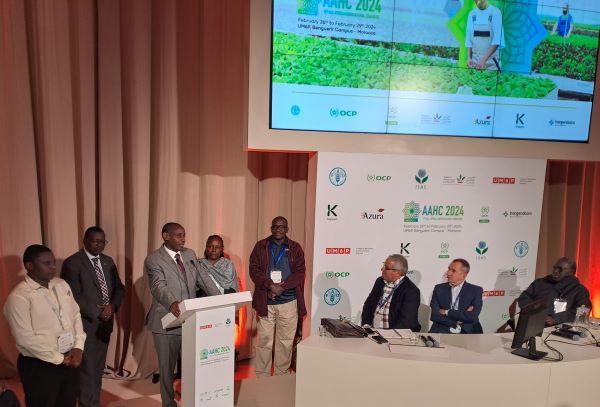
Aaron Fingasi presenting Uganda's candidacy for the AAHC 2028
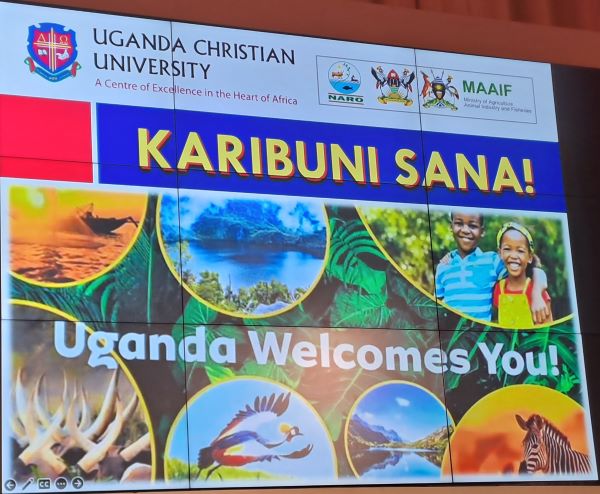
Related news
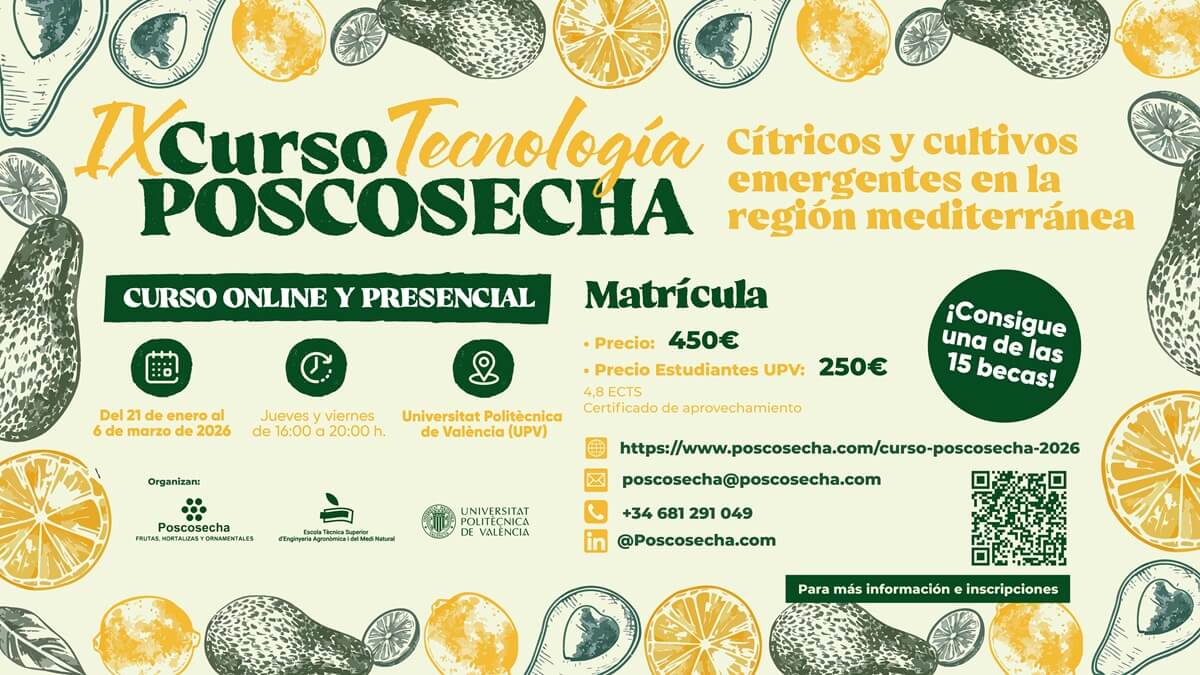



.png)








